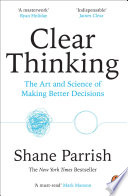

The book emphasizes that clarity in thought is the cornerstone of effective decision-making and problem-solving. Without clarity, individuals often find themselves lost in a maze of confusion, leading to poor judgments and outcomes. The author discusses various techniques for achieving clarity, such as breaking down complex problems into smaller, manageable components, and utilizing visual aids like mind maps. The importance of setting clear goals and objectives is also highlighted, as they serve as a guiding light in the decision-making process. Clarity enables individuals to see the bigger picture and understand the implications of their choices, thus fostering a more strategic approach to both personal and professional challenges.
Continue readingCritical thinking is presented as an essential skill that allows individuals to analyze situations, evaluate evidence, and construct logical arguments. The book outlines the steps involved in critical thinking, including identifying assumptions, questioning the validity of information, and considering alternative viewpoints. It encourages readers to cultivate a mindset of inquiry and skepticism, which can lead to more informed decisions. The author provides practical exercises and real-life scenarios to illustrate how critical thinking can be applied in everyday situations, from workplace dilemmas to personal relationships, thereby empowering readers to navigate complexities with confidence.
Continue readingCognitive biases are mental shortcuts that can lead to flawed reasoning and decision-making. The book delves into common cognitive biases, such as confirmation bias, anchoring, and availability heuristic, explaining how they can distort our perceptions and judgments. The author offers strategies for recognizing and mitigating these biases, such as seeking diverse perspectives, relying on data, and maintaining an open mind. By understanding and overcoming cognitive biases, individuals can enhance their decision-making processes, leading to more rational and objective outcomes. The discussion is enriched with examples from psychology and behavioral economics, illustrating the pervasive impact of biases in various contexts.
Continue readingEmotional intelligence (EI) is highlighted as a critical component of clear thinking. The book argues that being aware of one's emotions and the emotions of others can significantly influence decision-making. It discusses the five components of EI: self-awareness, self-regulation, motivation, empathy, and social skills. The author explains how high EI can lead to better interpersonal relationships and more effective collaboration in teams. Practical tips are provided for improving emotional intelligence, such as practicing active listening, managing stress, and developing empathy. The integration of EI into clear thinking practices helps individuals navigate social dynamics and make decisions that are not only rational but also considerate of others.
Continue readingStructured problem-solving is presented as a systematic approach to tackling challenges. The book outlines a framework for problem-solving that includes defining the problem, generating potential solutions, evaluating options, and implementing the chosen solution. The author emphasizes the importance of documenting the process to reflect on what worked and what didn’t, which can inform future decision-making. By following a structured approach, individuals can avoid the pitfalls of hasty decisions and ensure that they consider all relevant factors. The book provides case studies that demonstrate the effectiveness of structured problem-solving in various fields, from business to personal life.
Continue readingThe book discusses how our physical and social environments can significantly impact our thinking processes. It explores the concept of 'cognitive load' and how cluttered or chaotic environments can hinder clarity and focus. The author suggests strategies for creating an environment conducive to clear thinking, such as organizing workspaces, minimizing distractions, and fostering a positive social atmosphere. The role of culture and societal norms in shaping our thought processes is also examined, highlighting the importance of surrounding oneself with supportive and intellectually stimulating individuals. By consciously curating our environments, we can enhance our ability to think clearly and make better decisions.
Continue readingThe final key idea focuses on the necessity of continuous learning and adaptability in a rapidly changing world. The author stresses that clear thinking is not a static skill but one that must be cultivated over time through ongoing education and experience. The book encourages readers to adopt a growth mindset, embracing challenges and viewing failures as opportunities for learning. It discusses various methods for fostering continuous learning, such as seeking feedback, engaging in self-reflection, and staying curious about new ideas and perspectives. The ability to adapt one's thinking in response to new information is portrayed as a vital skill for personal and professional success.
Continue reading